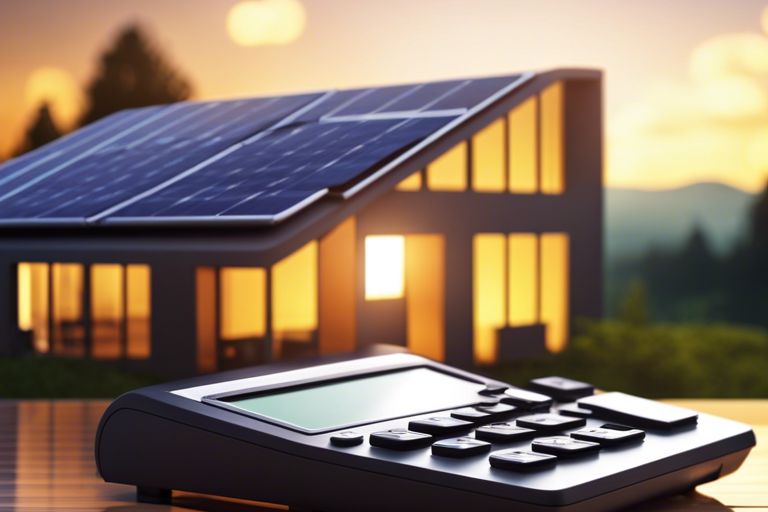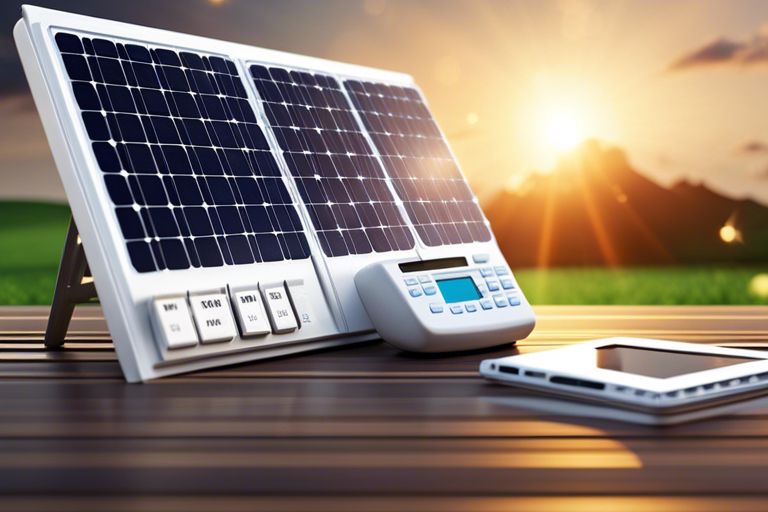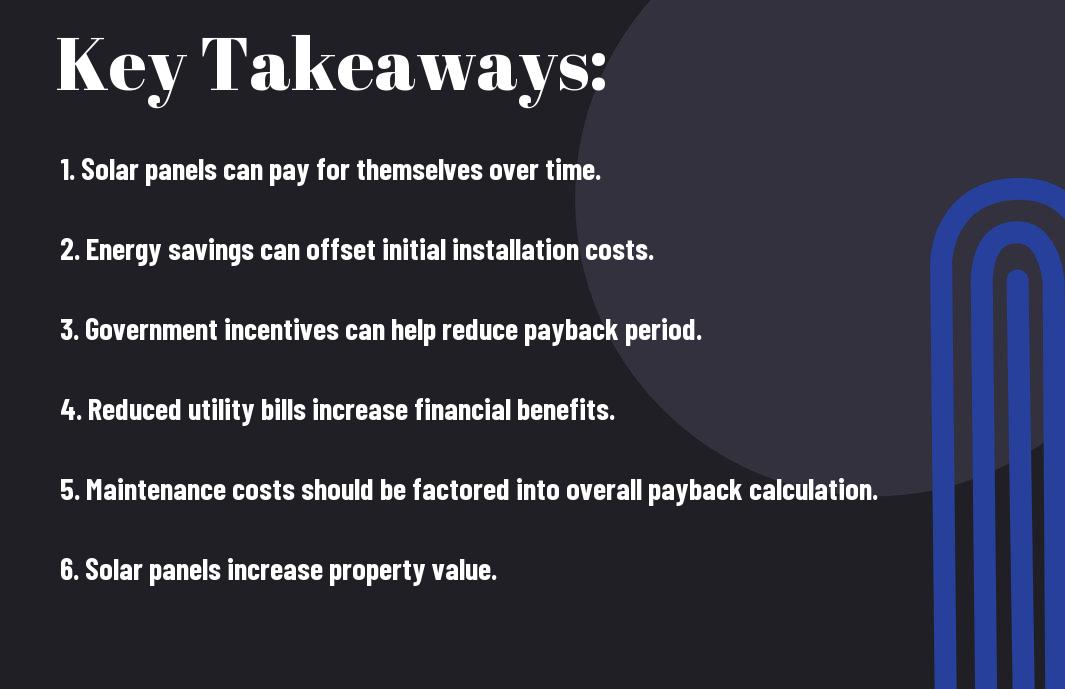Over the years, the concept of harnessing solar energy has grown increasingly popular as a sustainable and renewable energy source. When you are powered by solar energy, you are tapping into the incredible power of the sun to generate electricity for your home or business. By utilizing solar panels, you are reducing your carbon footprint, decreasing reliance on nonrenewable resources, and contributing to a cleaner, greener future for our planet. Let’s examine into what it truly means to be powered by solar energy and how it can benefit both you and the environment.
Key Takeaways:
- Renewable Energy Source: Being powered by solar energy means using a renewable energy source that is abundant and sustainable.
- Environmental Benefits: Solar energy helps reduce greenhouse gas emissions and dependence on fossil fuels, leading to a cleaner and healthier environment.
- Cost Savings: By harnessing solar energy, individuals and businesses can save money on electricity bills over time and even generate income through selling excess energy back to the grid.
Defining Solar Energy
What is Solar Energy?
To understand what it means to be powered by solar energy, you first need to grasp the concept of solar energy itself. Solar energy is the radiant light and heat from the sun that is harnessed using various technologies, such as solar panels, to generate electricity or heat water. This abundant and renewable energy source is important for sustaining life on Earth and is a key player in the transition to a cleaner, more sustainable future.
How Does it Work?
Energy from the sun is captured by solar panels made up of photovoltaic cells, which convert sunlight into electricity through the photovoltaic effect. These cells absorb photons from the sun, freeing electrons from atoms to generate an electric current. This electricity can then be used to power homes, businesses, and even entire cities, reducing reliance on fossil fuels and decreasing carbon emissions.
Understanding how solar energy works involves recognizing its potential to provide a clean and renewable source of power. By harnessing the sun’s energy, you can contribute to a more sustainable future for yourself and future generations. Embracing solar power means embracing a brighter, cleaner world powered by the endless energy of the sun.
Benefits of Solar Power
Environmental Advantages
For every kilowatt-hour of solar energy you use, you are reducing the demand for electricity from fossil fuels like coal, oil, and natural gas. This reduction in fossil fuel usage leads to lower greenhouse gas emissions, helping to combat climate change and reduce your carbon footprint. Additionally, solar power helps to conserve natural resources and protect ecosystems by decreasing the need for destructive practices like mountaintop removal mining or offshore drilling.
Cost-Effective
On top of the environmental benefits, solar power can also save you money on your electricity bills in the long run. While there is an initial investment in installing solar panels, you can potentially see a significant return on investment over time as you generate your own clean energy. Many governments and utilities also offer financial incentives, such as tax credits or rebates, to make solar power more affordable for homeowners and businesses.
With advancements in solar technology and increased competition in the solar industry, the cost of solar panels and installation has been steadily decreasing. This means that going solar is now more accessible and cost-effective than ever before, making it a smart financial choice for anyone looking to reduce their energy expenses.
Energy Independence
CostEffectiveBy generating your own electricity with solar panels, you can become less reliant on the traditional power grid and fluctuating energy prices. This energy independence gives you more control over your energy usage and costs, providing stability and security for you and your family. In the event of power outages or emergencies, having a solar power system with a battery backup can ensure that you still have electricity when you need it most.
To truly be powered by solar energy is to embrace a sustainable lifestyle that benefits both you and the planet. By harnessing the power of the sun, you can reduce your environmental impact, save money on energy bills, and gain greater energy independence. So why wait? Make the switch to solar today and start enjoying the numerous advantages it has to offer.
Types of Solar Energy Systems
All solar energy systems are designed to harness the power of the sun in different ways. Understanding the different types of solar energy systems can help you choose the right one for your needs. Here is a breakdown of the types of solar energy systems:
| Photovoltaic (PV) Systems | Solar Thermal Systems |
| Concentrated Solar Power (CSP) Systems |
Photovoltaic (PV) Systems
With photovoltaic systems, solar panels are used to convert sunlight directly into electricity. These panels are made up of photovoltaic cells that capture the sunlight and convert it into usable energy. The electricity generated by PV systems can be used to power homes, businesses, and even entire communities.
Knowing more about how PV systems work can help you understand the benefits of this type of solar energy. You can learn more about solar energy systems at Solar Energy – National Geographic Education.
Solar Thermal Systems
Energy from the sun can also be harnessed for heating purposes through solar thermal systems. These systems use collectors to absorb solar energy and heat transfer fluids to provide hot water, heating, and cooling. Solar thermal systems are efficient and environmentally friendly ways to meet your heating needs using solar power.
Concentrated Solar Power (CSP) Systems
An advanced form of solar power generation, Concentrated Solar Power (CSP) systems use mirrors or lenses to concentrate a large area of sunlight onto a small area. This focused light is then converted into heat, which drives a heat engine connected to an electrical power generator. CSP systems are capable of producing large amounts of electricity, making them suitable for utility-scale power generation.
It is important to understand the differences between these solar energy systems so you can make an informed decision about incorporating solar power into your life.
How Solar Energy is Harnessed
Not only does solar energy offer a clean and renewable source of power, but the way it is harnessed is also a fascinating process. Let’s research into the key components that make up a solar energy system.
Solar Panels and Cells
On your rooftop or in a solar farm, solar panels play a crucial role in capturing sunlight and converting it into usable electricity through photovoltaic cells. These cells are made of semiconductor materials such as silicon, which create an electric field when sunlight hits them. As photons from the sunlight strike the cells, they knock electrons loose, generating an electrical current.
Inverters and Converters
The heart of your solar energy system lies in the inverters and converters. The inverter’s job is to convert the direct current (DC) electricity generated by the solar panels into alternating current (AC) electricity that can be used to power your home or business. Converters help regulate the voltage and current to ensure that the electricity produced is compatible with the power grid.
The efficiency of your solar energy system is greatly influenced by the quality and capacity of the inverters and converters you choose. Selecting the right equipment can maximize the amount of electricity you can generate and use from your solar panels.
Mounting and Tracking Systems
Plus, the mounting and tracking systems play a crucial role in ensuring that your solar panels are positioned optimally to capture the most sunlight throughout the day. Mounting systems securely hold the panels in place, whether on your roof or on the ground, while tracking systems adjust the angle of the panels to follow the sun’s path for maximum exposure.
Cells in tracking systems can automatically adjust the position of the solar panels throughout the day to maximize sunlight absorption. This dynamic positioning helps increase the overall efficiency of your solar energy system and ensures you are getting the most out of your investment.
Starting with mounting brackets that keep your panels securely in place, ensuring they are in the optimal position to receive sunlight is crucial for maximizing the energy output of your solar panels. By using tracking systems that adjust the angle of the panels throughout the day, you can significantly increase the efficiency of your solar energy system and generate more power for your home or business.
Applications of Solar Energy
Residential Use
Unlike traditional sources of energy like coal or gas, solar energy can be harnessed right at your home. An increasing number of homeowners are choosing to install solar panels on their roofs to generate electricity. By capturing the sun’s energy, you can power your household appliances, reduce your electricity bills, and even earn credits for any excess energy you generate and send back to the grid.
Commercial and Industrial Use
An expanding number of businesses and industries are also turning to solar energy to meet their power needs. Large commercial buildings, factories, and warehouses can install solar panels on their rooftops or grounds to offset their electricity consumption. This not only helps to reduce operating costs but also demonstrates a commitment to sustainability and environmental responsibility.
A wide range of industries, from technology to agriculture, are integrating solar energy into their operations. By harnessing the power of the sun, businesses can improve their energy efficiency, reduce their carbon footprint, and create a more sustainable future for all.
Agricultural and Rural Use
To support agricultural activities in rural areas, solar energy can be a game-changer. Farmers can use solar panels to power irrigation systems, run farm equipment, and provide electricity to remote locations where traditional power sources are not easily accessible. By leveraging solar energy, farmers can increase efficiency, reduce costs, and promote environmental stewardship.
Agricultural communities are benefiting from the adoption of solar energy by gaining access to reliable and clean electricity. Solar power offers a sustainable solution to meet the energy needs of rural areas, helping to improve living standards and drive economic development in these regions.
Challenges and Limitations
After The Advantages and Disadvantages of Solar Energy, you may be aware of some challenges and limitations associated with solar power. One major issue is the intermittency of solar energy production and the lack of energy storage capabilities.
Intermittency and Energy Storage
Any energy generated by solar panels is dependent on sunlight, which means that production fluctuates throughout the day and is non-existent at night. This variability poses a challenge for meeting energy demands consistently. Energy storage solutions, such as batteries, are necessary to store excess energy generated during peak sunlight hours for use when the sun isn’t shining. Developing efficient and cost-effective energy storage technologies is crucial to overcoming this challenge.
High Upfront Costs
One of the primary barriers to adopting solar energy is the high upfront costs associated with installing solar panels and related equipment. For instance, purchasing and installing solar panels for your home or business requires a significant initial investment. While the long-term savings on energy bills can offset these costs over time, the initial financial outlay can be prohibitive for many individuals and organizations.
Land Requirements and Space Constraints
On top of the financial aspect, another challenge is the significant land area required for large-scale solar farms to generate enough electricity to be impactful. Another factor to consider is the space constraints in urban areas where available land for solar installations may be limited. Balancing the need for renewable energy generation with land use considerations is a complex issue that requires careful planning and innovation.
Another concern related to land requirements is the potential environmental impact of solar installations on ecosystems and habitats. It’s important to assess the land use implications of solar energy projects to minimize disruption to local flora and fauna.
To wrap up
With this in mind, being powered by solar energy means that you are embracing a clean, renewable source of power that is abundant, sustainable, and environmentally friendly. By harnessing the energy of the sun, you are reducing your carbon footprint and contributing to a healthier planet for future generations.
Embracing solar energy also means taking control of your energy consumption and becoming more self-sufficient. You are no longer reliant on finite fossil fuels and are instead tapping into a source of power that will never run out. By going solar, you are not only saving money on your energy bills but also investing in a brighter, more sustainable future for yourself and the world around you.
FAQ
Q: What does it mean to be powered by solar energy?
A: Being powered by solar energy means generating electricity by harnessing the sunlight and converting it into usable energy through solar panels or photovoltaic cells.
Q: How do solar panels work?
A: Solar panels work by absorbing sunlight through photovoltaic cells, which generate direct current (DC) electricity. An inverter then converts this DC electricity into alternating current (AC) electricity, which is used to power homes and businesses.
Q: What are the benefits of being powered by solar energy?
A: Some benefits of being powered by solar energy include reduced electricity bills, lower carbon footprint, energy independence, and potential incentives or tax credits for using renewable energy sources.
Q: Is solar energy reliable for powering homes and businesses?
A: Solar energy is a reliable source of power, especially in sunny regions. Additionally, with advancements in technology and the use of battery storage systems, solar energy can provide power even during cloudy days or at night.
Q: Are there any drawbacks to using solar energy?
A: While solar energy has numerous benefits, some drawbacks include the initial high cost of installation, the intermittency of sunlight, and the need for sufficient roof space or land for installing solar panels. However, the long-term savings and environmental benefits often outweigh these drawbacks.







